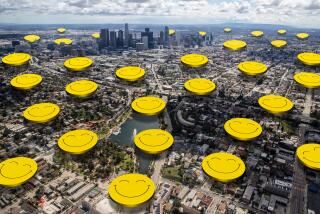Can you capture L.A.’s complexity in a photo book? ‘Both Sides of Sunset’ tries
Trying to define Los Angeles in photography is practically impossible. The city is so big. Its residents wildly diverse. An infinite number of artists — both locals and outsiders — have trained their cameras on the city. How to edit all of that down into a single 275-page book?
Somehow Jane Brown and Marla Hamburg Kennedy have done just that. In “Both Sides of Sunset: Photographing Los Angeles,” out this month from Metropolis Books, they edit decades of photography about the city into one portable (albeit weighty) coffee table tome.
Featuring the work of more than 125 artists from all over the world, the book contains images of L.A. that are both classic and unknown: from architectural photographer Julius Shulman’s dramatic black-and-white images of the Department of Water and Power Building from the mid-1960s to snaps of humble alleyways by contemporary L.A. photographer Peter Holzhauer, who often finds humor in the banal.
There are conceptual images by John Baldessari, showing bright orange balls sailing above a horizon dotted with palm trees, and the journalistic pictures made by Douglas Kirkland, a Canadian-born photographer who shot for Look and Life magazines, and who, in 1970, captured actress Jeanne Moreau, shooting a surreal scene from Paul Mazursky’s Hollywood fable “Alex in Wonderland.” There are moments of glamor and images that capture the city on days in which it looks as if it were beat with an ugly stick.
The book also has an interesting layout.
Reading “Both Sides of Sunset” is like admiring a Rube Goldberg machine, in which one object sets off the next and then the next. A close-up image of a textile block wall by James Welling, from 2003, is followed by a vintage image of a similar architectural detail from 1976 by Philip Melnick. A view from a window leads to a view of a gate, which leads to overlooked architectural corners and a series of images that chronicle the ways in which the natural and the synthetic mingle in strange ways.
The book, writes, Times book critic David Ulin, in the introduction, is intended to “evoke L.A. in all its contradictory glory, its inexplicable and very human life.”
And in that way, it’s indeed like L.A.: a bit of a hot mess. The book is heavy on images and short on text. There are no captions on the photos, just titles. In this way, it is very democratic. There is no differentiation between staged pictures that document conceptual art happenings and more news-driven works that chronicle the city in straightforward ways, just as there is no differentiation between photographic legends and those who are just starting out.
This makes “Both Sides” all about the images — which makes it a wonderful book with which to revel in the wild architecture, the burned-out rocker types, the overpowering roadways, the singular street life, the sublime ridiculosity.
But if you want context, you’ll have to turn to Google to find out that Bill Ray’s image of Watts was shot a year after the 1965 riots for Life magazine. Or that the strange dinner scene in a traffic medium that Harry Gamboa captured in 1974 is a work of performance art by the collective Asco.
The book is also weak on certain communities. It’s strong on downtown, Beverly Hills and Hollywood (both the literal city and the abstract concept). And there is plenty of modern architecture. But “Both Sides of Sunset” is weak on places like Compton and Lynwood and Torrance and Artesia, historic black neighborhoods and buzzing Asian and Latino immigrant communities.
It could have used Howard Bingham‘s portraits, Gusmano Cesaretti‘s street scenes, Estevan Oriol‘s bouncing cars and the community life captured by José Gálvez over decades. For the next compendium, I’d also suggest a trip to the Cal State Northridge African American Photography Collection.
But that doesn’t make “Both Sides of Sunset” any less compelling. No overview of Los Angeles is ever going to be complete. Our city is too big, too atomized, too much of everything all at once. All we can ever see is one tiny bit of it at a time. And this book offers plenty of wondrous bits.
“Both Sides of Sunset: Photographing Los Angeles” ($75) is available this month from Artbook / D.A.P. David Ulin will moderate a panel tied to the book with artists Zoe Crosher, Bettina Hubby, Michael Shields and Ed Templeton at 3 p.m. June 27 at the Museum of Contemporary Art. MOCA Grand Ave., 250 S. Grand Ave., downtown Los Angeles, moca.org.
Find me on Twitter @cmonstah.
More to Read
The biggest entertainment stories
Get our big stories about Hollywood, film, television, music, arts, culture and more right in your inbox as soon as they publish.
You may occasionally receive promotional content from the Los Angeles Times.











